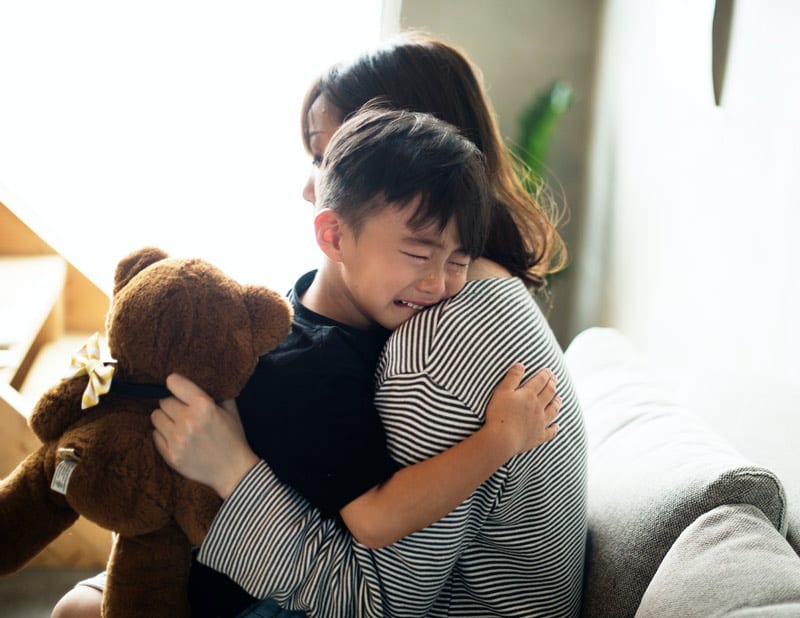If your mornings are fraught with a crying child, panicked screams, clinging arms — this article is for you. Whether it’s your child’s first time in a classroom or this is an annual occurrence, separation anxiety can make every day a challenge. Families struggling with these morning rituals may feel as if there’s no hope, but we’re here to tell you that you’re not alone, and there are some ways you can slowly but surely make life easier for both you and your child.
While nobody expects their child to be ecstatic about returning to school, the raw and terrifying emotions she exhibits on those mornings are about more than her fear of homework. It can be confusing and difficult to console her, especially for parents or caregivers who may not fully understand what’s going on. In the end, both children and parents are at a loss for words, unable to make meaningful progress or establish a healthy routine for separating for the day.
Fortunately, there are ways to make it through the day and make each new day better. Let’s dive in.
Separation Anxiety Statistics in Children
- Separation anxiety is highly treatable
- Most common symptoms of separation anxiety occur with preschoolers and early school-age children
- The first symptoms of severe separation anxiety often present themselves around the third or fourth grade
- Separation anxiety occurs equally in males and females
- Children whose parents have anxiety disorders are more likely to develop separation anxiety
What is Separation Anxiety
Before we go any further, we want to express that separation anxiety is completely normal. It has its place in evolution, keeping children close to their protectors and far from the dangers of the unknown. It’s natural for children to fear any form of separation or distance from their parents, just like parents feel fear when their child is away from them or in someone else’s care.
Some common symptoms include:
- Refusing to attend school
- Refusing to sleep alone
- Unhealthy worries about the safety of family members
- Reluctance or worry about being alone
- Recurrent nightmares about separation
- Constant stomachaches, headaches, or other aches
- Temper tantrums or panic when separating from parents or caregivers
Letting go of anxiety can be difficult, but recognizing the absence of legitimate danger and slowly letting go of unhealthy anxiety is the goal. Attempting to eliminate it entirely from the start only sets the stage for further issues — so, baby steps.
Yes, separation anxiety can become a significant issue when severe cases interfere with healthy development, socialization, friendships, or even physical wellness. Suppose a child altogether refuses to attend school, or the anxieties are extending well beyond the age-appropriate levels of separation anxiety — a doctor may make a separation anxiety disorder diagnosis and divulge a treatment plan. They may suggest therapy or some sort of counseling.
However, this is a far less common issue, and normal levels of separation anxiety are what many of you are experiencing with your child today.
Dos and Don’ts of Separation Anxiety
We know that dealing with a child struggling with separation anxiety can be draining, difficult, and emotionally disruptive. And truth be told, easing your child’s problems is also about making your life less stressful — and there’s nothing wrong with that. You may not be able to fix her irrational worries or fears, but you can strengthen her resolve and offer building blocks to build a healthy sense of self to help in the long run.
What You Should and Shouldn’t Do
What you should do is keep communication open and talk about these issues before they occur. It will be difficult to have a meaningful conversation when your child is screaming or panicking. Plan ahead. If school is around the corner and you know he’s anxious about it, take the time to talk about it in the week leading up to his first day. If school has already started, talk about the next day every night before bed. Prepare him by helping pick out his clothes, pack his backpack, and make his lunch together (if he brings his own). Eliminate surprises to help ease his stress.
What you shouldn’t do is introduce worry or fear, especially if he’s not showing any signs in the first place. If he’s having a great morning, the last thing you want to say is, “are you worried about your first day?” Sometimes, these seemingly harmless questions or comments open up fears or anxieties in areas where there shouldn’t be any.
What you should do is introduce her to her school environment before she goes off on her own. This may include the playground or open houses to get her acquainted with various areas in the school. Show her around the hallways, the classrooms, her locker, or cubby. Meeting her teachers and seeing the school before she goes off into the unknown can help relieve some anxieties and stress.
What you shouldn’t do is take the helicoptering to an extreme. We know it’s difficult to see your child feel uneasy, but you have to set an example and establish healthy boundaries for hand-holding. You want to give her some semblance of independence here and there, whether it be having her say goodbye to her new teacher all on her own or venturing into the playground without your help. Don’t forget to give her a pat on the back for showing independence or achieving some individual victories when you get home.
What you should do is stick to a routine, especially when it comes to goodbyes. For children struggling with anxieties or worries, routines help create balance and sturdy ground to stand upon. Whether it’s a kiss on the cheek, a hug, a fun saying, or a secret handshake — these routines help solidify the “goodbye experience.” No matter the routine, it’s important that it’s followed by the parent actually leaving. If you linger or get convinced to stay just a little longer, the routine doesn’t succeed in establishing healthy separation.
What you shouldn’t do is get baited into staying too long or lingering. Whether it’s tears or leg tugging, children will learn that their pleading reaped a positive reward for them — and it can be difficult to break that over time.
What you should do is control your own emotions. Now, we’re not saying you have to be a stoic and expressionless parent — but you want him to feel safe and secure with your decision to let him go off on his own. The more worry and fear he sees in your face, the more terrified he’ll be. So, toughen up and do your best to appear calm, collected, and confident in your kiddo.
What you should NEVER do is leave or sneak out when he’s busy or not looking. Every parent dealing with a child who struggles with separation anxiety has thought about it, and while it is the quickest and simplest “solution,” it can be damaging. It’s a way to avoid the issue and build a crippling loss of trust. Every time he turns his back on you, he’ll worry that you’ll be gone.
Some Closing Thoughts
Children’s emotions can be turbulent and filled with illogical fears, many of which contribute to separation anxiety. It’s important for parents to recognize and acknowledge these emotions. You can speak with your child about anxiety and normalize her feelings without belittling her.
Here’s an example of what you can say:
It’s OK to be anxious; it’s completely normal. Sometimes, we fear things to keep us safe, but you will be safe at school, and I’ll be right here when you get home. I promise. Just like when you wake up every morning, I’m right here, I’ll be right here when you’re done with school.
It may seem like rewarding or punishing her may get the job done, but that doesn’t work for emotions, only behaviors. Whether it’s limiting screen time or offering a treat — you don’t want to positively or negatively reinforce her feelings because we all feel what we feel for a wide range of reasons.
Hang in there, parents. We know it’s tough. Hopefully, these tips will better prepare you and your child for those tough mornings or long nights.
If you or someone you know experiences mental health issues, it is important to seek help from a qualified professional. Our Resource Specialist can help you find expert mental health resources to recover in your community. Contact us now for more information on this free service to our users.
About the Author
Matt Grammer, LPCC-S
Founder, Owner of Kentucky Counseling Center
LinkedIn
Image by www.rawpixel.com
The opinions and views expressed in any guest blog post do not necessarily reflect those of www.rtor.org or its sponsor, Laurel House, Inc. The author and www.rtor.org have no affiliations with any products or services mentioned in the article or linked to therein. Guest Authors may have affiliations to products mentioned or linked to in their author bios only.
Recommended for You
- Veterans and Addiction Recovery: How Families Can Support Their Service Member’s Healing Journey - July 14, 2025
- Trauma-Aware Yoga: A Gentle Path to Healing and Recovery - July 10, 2025
- Why Eating Disorders in Men Are Often Missed - July 3, 2025





